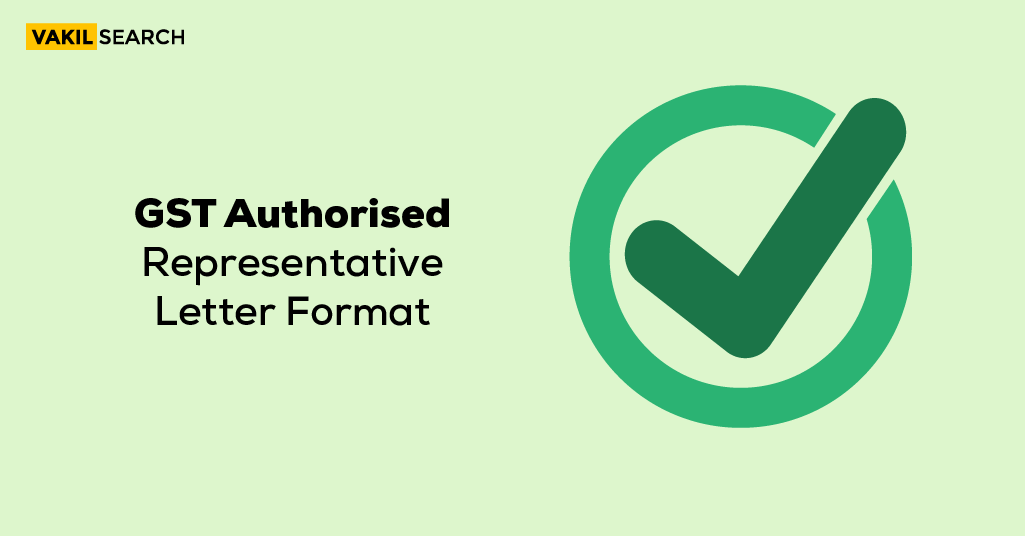Explore the importance of the GST authorised Representative Letter Format in ensuring adherence to intricate GST regulations. A detailed guide for businesses navigating the complexities of Goods and Services Tax.
Introduction
In the complex landscape of Goods and Services Tax (GST), businesses often find themselves navigating a myriad of rules and regulations. One crucial aspect is appointing a GST authorised Representative, a role that plays a pivotal role in ensuring compliance with GST norms. This article looks into the GST authorised Representative Letter Format, shedding light on its significance and providing valuable insights for businesses.
Importance of GST Authorised Representative
Navigating Complex GST Regulations
The ever-evolving nature of GST regulations can be overwhelming for businesses. Having a designated authorised representative ensures that someone well-versed in GST laws is on board to guide the company through the complexities.
Ensuring Compliance
Compliance with GST rules is not only a legal requirement but also essential for maintaining a smooth business operation. A well-prepared GST authorised Representative Letter serves as a formal document designating an individual or entity to act on behalf of the business, emphasising the commitment to compliance.
Components of a GST Authorised Representative Letter
Business Details
The letter should start with comprehensive details about the business, including its name, address, GSTIN (Goods and Services Tax Identification Number), and any other relevant information. This sets the foundation for a clear and concise representation.
Authorised Representative Details
Provide detailed information about the authorised representative, including their name, address, contact details, and their unique identification details. This ensures that there is no ambiguity about the appointed representative.
Scope of Authority
Clearly outline the scope of authority granted to the representative. Specify whether their role is limited to filing returns, attending hearings, or extends to other GST-related matters. This section ensures that both parties have a mutual understanding of the representative’s responsibilities.
Duration of Representation
Define the duration for which the authorised representative is appointed. Whether it is for a specific project, a financial year, or an open-ended arrangement, specifying the time frame adds clarity and avoids any potential misunderstandings.
Notarisation and Authentication
To lend the letter legal validity, consider having it notarised or authenticated by appropriate authorities. This step varies by jurisdiction, so it’s crucial to be aware of the local requirements to ensure the document’s acceptance in official proceedings.
Crafting an Effective GST Authorised Representative Letter
Clarity and Precision
The language of the letter should be clear, precise, and free from ambiguity. Avoid legal jargon that might be confusing for those not well-versed in tax laws. A straightforward document ensures that all parties involved fully understand the terms and conditions.
Alignment with Regulatory Changes
Given the dynamic nature of GST regulations, it’s imperative to align the authorised representative letter with any recent changes in the tax laws. This proactive approach ensures that the representation remains compliant with the latest statutory requirements.
Inclusion of Relevant Statutory References
To bolster the document’s credibility, consider including references to relevant GST laws and sections. This not only showcases a thorough understanding of the legal landscape but also reinforces the legality of the representation.
Potential Challenges and Solutions
Changing Representatives
In situations where there is a need to change the authorized representative, it’s essential to have provisions in the letter addressing the process for such changes. This ensures a smooth transition without disrupting ongoing GST-related activities. Additionally, if this change in representation leads to a significant modification in business operations or company structure, it may be necessary to consider applying for a new GST registration. This would ensure that all GST filings and responsibilities are accurately maintained under the updated business details, supporting continued compliance with GST regulations.
Dispute Resolution Mechanism
Incorporating a dispute resolution mechanism within the letter can be beneficial. This can include specifying the steps to be taken in case of disagreements between the business and the authorised representative, preventing potential legal complications.
Tips for Businesses Appointing GST authorised Representatives
Due Diligence
Before appointing an authorised representative, conduct thorough due diligence. Ensure that the individual or entity has a sound understanding of GST laws, a track record of compliance, and the capacity to fulfil the designated responsibilities.
Communication
Maintain open lines of communication with the authorised representative. Regular updates on changes in the business, tax structure, or any other relevant information will enable them to perform their duties effectively.
Regular Review
Periodically review the performance of the authorised representative. This ensures that they continue to meet the business’s needs and remain aligned with the evolving GST landscape.
Conclusion
In conclusion, the GST Authorised Representative Letter Format stands as a critical document in formalising the relationship between a business and its designated representative in navigating the intricacies of GST compliance. Crafting a comprehensive letter is essential for seamless operations, avoiding legal complications, and fostering a culture of compliance. VakilSearch, with its expertise in legal documentation, can assist businesses in creating robust and legally sound GST Authorised Representative Letters, ensuring adherence to regulatory requirements and promoting a hassle-free compliance journey.
FAQs
Why is it necessary to have a GST Authorised Representative Letter?
The GST authorised Representative Letter is crucial as it formally designates an individual to navigate the complexities of GST compliance on behalf of a business. It establishes a legal framework, ensuring adherence to regulations and streamlining communication with tax authorities.
What information should be included in the Business Details section of the letter?
The Business Details section should encompass the business name, address, GSTIN, and other pertinent information. Providing a comprehensive overview ensures a clear foundation for the authorised representative, facilitating seamless interaction with tax authorities and regulatory bodies.
How can the letter be aligned with regulatory changes in GST laws?
To align with regulatory changes, regularly review and update the authorised representative letter. Stay informed about amendments in GST laws, ensuring that the document remains compliant with the latest statutory requirements, thereby safeguarding the business against potential legal implications.
Is it necessary to notarise or authenticate the GST authorised Representative Letter?
While not mandatory, notarising or authenticating the letter can enhance its legal validity. The decision depends on jurisdictional requirements. Taking this step provides an additional layer of assurance, ensuring acceptance of the document in official proceedings related to Goods and Services Tax.
What should businesses consider when appointing a GST authorised Representative?
Prior to appointment, businesses should conduct thorough due diligence. Ensure the chosen representative possesses a sound understanding of GST laws, a track record of compliance, and the capacity to fulfil the designated responsibilities. This proactive approach mitigates risks and fosters a culture of tax compliance.










